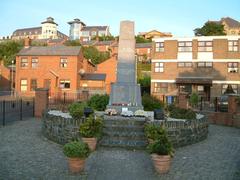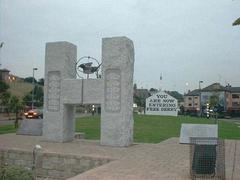Walker Memorial Plinth Derry: Visiting Hours, Tickets, and Historical Sites Guide
Date: 14/06/2025
Introduction
The Walker Memorial Plinth, set atop the Royal Bastion of Derry’s historic city walls, is a lasting symbol of the city’s turbulent history and remarkable resilience. Originally constructed in 1826 to honor Reverend George Walker’s leadership during the 1689 Siege of Derry, the monument once featured an imposing 25-metre-high column and statue that dominated the skyline as a potent symbol of Protestant endurance (BBC News). Though the statue and column were destroyed in 1973 during the Troubles, the plinth remains as a witness to Derry’s evolving identity and efforts at reconciliation.
Today, visitors can explore the plinth as part of the renowned Derry City Walls walking circuit, enjoying panoramic city views and engaging with a site steeped in layered history. Restoration, interpretive panels, and community-led art projects have reimagined the plinth as a space for dialogue and reflection. This comprehensive guide covers visiting hours, ticket details, historical context, accessibility, travel tips, and nearby attractions—ensuring a meaningful and well-informed visit to one of Northern Ireland’s most significant historical sites.
Table of Contents
- Origins and Construction
- Symbolism and Controversy
- The Plinth in the Modern Era
- Architectural and Historical Context
- Cultural Legacy and Community Relevance
- Visitor Information
- Visitor Experience and Visual Highlights
- Safety and Security
- Frequently Asked Questions (FAQ)
- Conclusion
- Sources and Further Reading
Origins and Construction
The Walker Memorial Plinth is the surviving base of what was once a towering monument, dedicated to Reverend George Walker, a joint governor and key Protestant leader during the 1689 Siege of Derry. Erected in 1826, the original monument’s location atop the Royal Bastion was carefully chosen due to its critical defensive role during the siege. The 25-metre-high column and statue served as both a commemoration of Walker’s leadership and a visible assertion of Protestant identity (History Hit).
The Siege of Derry and George Walker
The 1689 Siege of Derry is remembered as a defining moment in Irish and British history. Lasting 105 days, the siege saw Protestant citizens, led by Walker and others, successfully resist the forces of the deposed Catholic King James II. The event, sparked by the Apprentice Boys’ famous closing of the city gates, led to significant loss of life due to starvation and disease, but ultimately became a cornerstone of Protestant heritage in Northern Ireland (BBC News).
Symbolism and Controversy
From its inception, the Walker Monument was more than a memorial—it was a powerful, and at times divisive, symbol. Its prominent placement facing the Catholic Bogside neighborhood was interpreted by many as an assertion of dominance, particularly during periods of sectarian conflict (History Hit). During the Troubles, the monument became a flashpoint for tensions; in August 1973, the IRA destroyed the column and statue with a bomb, leaving only the plinth as a silent witness to the conflict (History Hit).
The Plinth in the Modern Era
For decades, the plinth stood inaccessible and derelict, symbolizing both physical and social scars. However, in recent years, significant restoration and reinterpretation efforts have transformed the site. The Royal Bastion and plinth reopened to the public in 2019, following extensive conservation work. Initiatives such as the Plinth Commissions have involved local artists and residents in reclaiming the space with public art installations—turning the plinth into a space of shared heritage and dialogue (BBC News).
Architectural and Historical Context
The Walker Memorial Plinth is integrally linked to Derry’s city walls—among the best-preserved 17th-century fortifications in Europe. Built between 1613 and 1618, the walls were never breached, even during the siege, and encircle the old city in a 1.5-kilometre circuit (History Hit). The Royal Bastion, where the plinth stands, remains a focal point for understanding both the city’s defense and its complex past. The plinth itself is a listed historic structure, now protected and maintained as part of the city’s conservation area (NI Government Buildings Database).
Cultural Legacy and Community Relevance
The plinth’s significance has evolved along with Derry itself. While annual commemorations by groups like the Apprentice Boys of Derry maintain ties to the 1689 siege, new community and artistic initiatives have broadened the narrative, inviting all residents and visitors to engage with the site’s meaning (BBC News). The plinth stands today as a symbol of both remembrance and renewal, reflecting Derry’s ongoing journey toward reconciliation.
Visitor Information
Visiting Hours and Tickets
- Open: Year-round as part of the Derry City Walls walking circuit.
- Hours: Typically 9:00 am – 6:00 pm (March–October), 9:00 am – 4:00 pm (November–February), though daylight hours and special events may affect access.
- Admission: Free for independent visits. Guided tours (including the plinth) are available via the Siege Museum, with tickets purchasable online or on-site (Visit Derry).
Accessibility
While restoration has improved access with ramps and pathways, some sections of the city walls, including the Royal Bastion, involve steps and uneven surfaces (News Letter). Visitors with mobility concerns should consult Visit Derry or the Siege Museum for up-to-date accessibility information and alternative routes.
Travel Tips and Nearby Attractions
- Getting There: The plinth is on Derry’s city walls, accessible via Society Street and within walking distance from the city centre.
- Nearby Attractions: The Siege Museum, Bogside murals, Guildhall, St. Columb’s Cathedral, and the Tower Museum.
- Facilities: Restrooms and refreshments available nearby; the Siege Museum gift shop offers books and souvenirs.
Guided Tours and Special Events
- Guided Tours: Highly recommended for in-depth historical interpretation. Tours depart from the Siege Museum and include the plinth, city walls, and key sites (Visit Derry).
- Special Events: The site becomes a focal point during parades like the Relief of Londonderry (August) and Shutting of the Gates (December), which commemorate the siege and attract large crowds.
Visitor Experience and Visual Highlights
- Panoramic Views: From the plinth, enjoy sweeping vistas over the River Foyle, the Bogside, and Derry’s western districts—a favorite spot for photography.
- Interpretive Panels: On-site panels provide accessible historical context.
- Public Art: Recent installations and community projects animate the plinth, reflecting contemporary cultural engagement.
Suggested visual: High-resolution image of the panoramic view from the plinth with alt text: “Panoramic view of Derry from Walker Memorial Plinth showcasing River Foyle and Bogside.”
Safety and Security
The plinth is generally safe for visitors, though it has been subject to occasional vandalism—most recently, paint attacks in July 2024 and April 2025, investigated as hate crimes (BBC News; Irish News). Police patrols and surveillance have increased. Visitors are encouraged to respect the site’s sensitivities and report suspicious activity.
Frequently Asked Questions (FAQ)
Q: What are the Walker Memorial Plinth visiting hours?
A: The site is accessible during city walls opening hours: 9:00 am – 6:00 pm (March–October), 9:00 am – 4:00 pm (November–February). Check with Visit Derry or the Siege Museum for updates.
Q: Is there an entrance fee?
A: No, access to the plinth and city walls is free. Guided tours may require a ticket.
Q: Is the site wheelchair accessible?
A: Some improvements have been made, but uneven terrain and steps remain. Consult local visitor centers for the latest accessibility information.
Q: Are guided tours available?
A: Yes, via the Siege Museum and other local heritage organizations.
Q: Can I take photographs?
A: Absolutely—photography is encouraged, especially for the panoramic views.
Q: What security measures are in place?
A: Increased police presence and surveillance help protect the site and visitors.
Conclusion
The Walker Memorial Plinth stands as a testament to Derry’s layered history and continuing narrative of renewal. Whether you’re interested in history, architecture, art, or community, the plinth offers a meaningful connection to the city’s past and present. Plan your visit to engage with this unique landmark and explore Derry’s rich cultural landscape. For real-time updates, event listings, and immersive experiences, download the Audiala app and follow official tourism channels.
Sources and Further Reading
- BBC News
- History Hit
- Visit Derry
- The Rambling Wombat
- Police Service of Northern Ireland (PSNI)
- Siege Museum Guided Tours
- News Letter
- Derry Now
- NI Government Buildings Database
- Irish News



